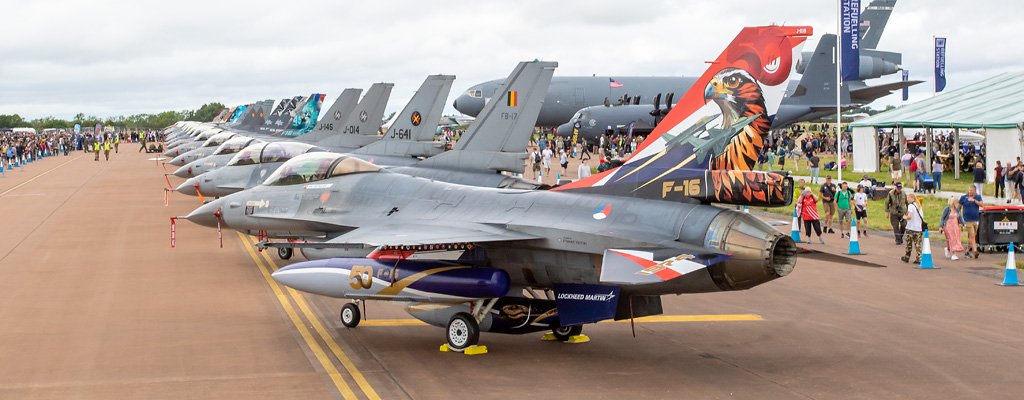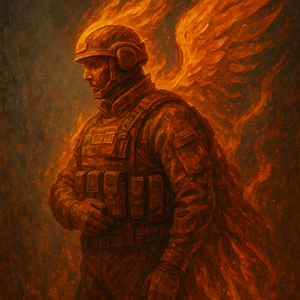Every July, the Royal International Air Tattoo (RIAT) offers a spectacular showcase of global air power, where the latest technology and the finest pilots converge. The 2025 event, held from 18-20 July, was no exception. Yet for seasoned observers and supporters of Ukraine, there was a stark and noticeable difference compared to previous years: the conspicuous absence of the Ukrainian Air Force's celebrated aircraft from the flying and static displays.
In past years, Ukraine's participation was a highlight, a powerful symbol of defiance and skill. This year, the lack of a thundering Su-27 display or a formidable Il-76 on the tarmac led some to question the meaning of this low-key presence. However, a deeper analysis reveals that this was not a sign of weakness or waning engagement. Instead, Ukraine's minimal public profile at the world's premier airshow was a powerful, calculated statement of strategic maturity, intense operational focus, and a pivot from public spectacle to the substantive work of building a victorious and sustainable fighting force.
The Unmistakable Reality of Operational Tempo
The most direct reason for Ukraine's light footprint at RIAT is the unrelenting reality of the war. In mid-2025, the conflict demands the full commitment of every critical military asset. Every operational fighter jet, along with its highly skilled pilot and dedicated maintenance crew, is a precious resource tasked with defending Ukrainian skies. Similarly, the Il-76 transport fleet acts as the vital lifeline for the entire war effort, constantly flying missions to deliver critical equipment and personnel to the front.
From a strategic perspective, pulling these combat-active assets and their crews from their duties for several days to participate in an airshow is a luxury a nation at war simply cannot afford. Ukraine's decision reflects a correct and disciplined prioritisation of combat effectiveness over public relations. The absence of its aircraft at RAF Fairford was a quiet but clear testament to their constant presence where they are needed most: in the skies over Ukraine.
A Pivot from Public Display to Private Diplomacy
While the crowds did not see Ukrainian hardware, the country's strategic objectives at RIAT were arguably more focused and consequential than ever before. Ukraine's approach to international events has matured in line with its evolving needs. In the early stages of the full-scale invasion, public displays were vital for rallying global support and demonstrating the will to fight. Today, the nature of that support is far more complex.
The real work for the small, high-level Ukrainian delegation at RIAT 2025 took place not on the tarmac, but behind the scenes in a series of crucial, closed-door meetings. The discussions with defence ministers, air chiefs from the Royal Air Force and United States Air Force, and CEOs of major defence contractors have moved beyond general commitments. The agenda is now focused on the intricate details of F-16 sustainment chains, establishing domestic maintenance and production facilities for Western systems, and securing long-term industrial partnerships. This substantive, high-level engagement has become the priority, reflecting a strategic shift from winning hearts and minds to building the logistical and industrial backbone of a future, self-reliant military.
The "Virtual" Presence: A Nation at the Centre of Every Conversation
Although Ukraine's aircraft were physically absent, its influence was pervasive and dominated the intellectual space of the entire event. The official theme of RIAT 2025, "The Future of Air Power," was debated almost entirely through the lens of the lessons being learned in the skies over Ukraine.
In strategic forums and industry chalets, every significant conversation was shaped by Ukraine's experience. Discussions about the next generation of fighter jets were informed by the need for survivability in heavily contested airspace. The innovation zones, filled with the latest counter-UAS technologies, were a direct response to the drone war that Ukraine is pioneering. The challenges of integrating disparate fleets of aircraft and the critical need for resilient, networked communication in a dense electronic warfare environment were all discussed with Ukraine as the primary case study. In effect, Ukraine's experience has become the world's most valuable and urgent dataset for understanding modern warfare, making its presence felt in every high-level discussion.
A Statement of Strategic Maturity
Ukraine's quiet presence at RIAT 2025 was a masterclass in strategic communication. It was the statement of a nation that has moved beyond the need for symbolic gestures and is now entirely focused on the substantive, difficult work of winning a war and securing its future. The absence of its aircraft was a sign of a military completely engaged in the fight. The focus on high-level meetings was a sign of a government building deep, lasting industrial partnerships. And the constant discussion of its experiences was a sign of a nation whose influence on the future of air power is now undeniable.
The most powerful message from Ukraine at RIAT 2025 was not delivered by the roar of a jet engine, but by a quiet and determined focus on the real priorities of a nation at war. It was the eloquence of absence.

.svg)


